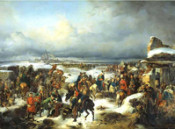
Russian army occupies Kohlberg Fortress during the Seven Years’ War of 1756-1763
5 (16) December, 1761 after a long siege, Russian troops under the command of Count Rumyantsev-Zadunaisky took Kohlberg Fortress. Battles for Kohlberg made an important contribution to the development of Russian and world art of war.
Seven Years' War, which broke out in Europe in the years 1756-1763, was caused by the aggravation of the Anglo-French struggle for colonies and the clash between Prussia policy and the interests of Austria, France and Russia. During the military campaign, the only major event of 1761 was a four-month siege and capture of Kolberg fortress - the port on the Baltic coast - by Russian troops under the command of General P. A. Rumyantsev. Occupation of Kolberg – an advantageously located foothold in Pomerania – was an important strategic task for the Russian army.
The first attempts of Russian troops to take Kohlberg during the Seven Years’ War in 1758 and 1760 failed. In September 1761 the third attempt was made, when the fortress was attacked by 22 thousand Corps of General Rumyantsev, who had successfully commanded a brigade near Gross-Jägersdorf (1757) and a division in the Battle of Kunersdorf (1759). In August 1761 Rumyantsev, the first time in the history of Russian military weapons, used elements of tactical system "column – extended order" and, eventually, defeated the Prussian army under the command of Prince of Wurttemberg at the approaches to the fortress. In this battle, and later the Russian ground forces were supported by the Baltic Fleet, commanded by Vice Admiral A. I. Polansky.
3 (14) September the Corps under General Rumyantsev began the siege of Kohlberg. The siege lasted four months and was accompanied by military actions against the Prussian army, which threatened Russian troops from the rear. Hunger and lack of ammunition forced the Prince of Wurttemberg leave the fortress’ defenders. October 31 (November 11) prince’s corps, having left the camp at the walls of the fortress, tried to get to the rear of Russian troops. This attempt was suppressed by Rumyantsev, who divided his forces into two corps: the siege one and observation one. The latter defeated the troops of the Duke of Wurttemberg on 1 (12) November. This victory finally decided the outcome of the battle of Kohlberg. Garrison had held the line for some time, but having exhausted the supplies of food, was forced to capitulate. It happened on 5 (16) December. Capture of Kohlberg enabled Russian troops to occupy the Baltic coast of Prussia.
The battle of Kohlberg marked the beginning of a new military tactics: extended order. It was under the walls of Kohlberg where the famous Russian Light Infantry was born - chasseurs, whose experience was in future used by other European armies. Near Kohlberg Rumyantsev was the first to use battalion columns in combination with extended order. This experience was later used effectively by Russian military commander and military theorist Alexander Suvorov. This way of fighting was implemented in Europe only during the wars of the French Revolution in the late 18th century.
Lit.: Архенгольц И. В. История семилетней войны. М., 2001; То же [Электронный ресурс]. URL: http://militera.lib.ru/h/archenholz/index.html; Веселаго Ф. Ф. Краткая история Русского Флота. М.; Л., 1939. Гл. 6. Русский флот в период от начала «Семилетней войны» (1756–1763 гг.) до русско-турецкой войны (1768–1774 гг.); То же [Электронный ресурс]. URL: http://militera.lib.ru/h/veselago_ff/06.html; История военного искусства / Под общ. ред. П. А. Ротмистрова. T. 1. М., 1963; Констам А., Янгхазбенд Б. Русская армия в Семилетней войне. Пехота. М., 2004; Констам А. Русская армия в Семилетней войне. Кавалерия и артиллерия. М., 2005; Семилетняя война. Материалы о действиях русской армии и флота в 1756-1762 гг. М., 1948.
Based on the Presidential Library’s materials:

